Thanks to research in the Pine Ridge, we are gaining knowledge about one of Nebraska’s most criticized, treasured and, of course, misunderstood repatriates – the cougar.
Enlarge
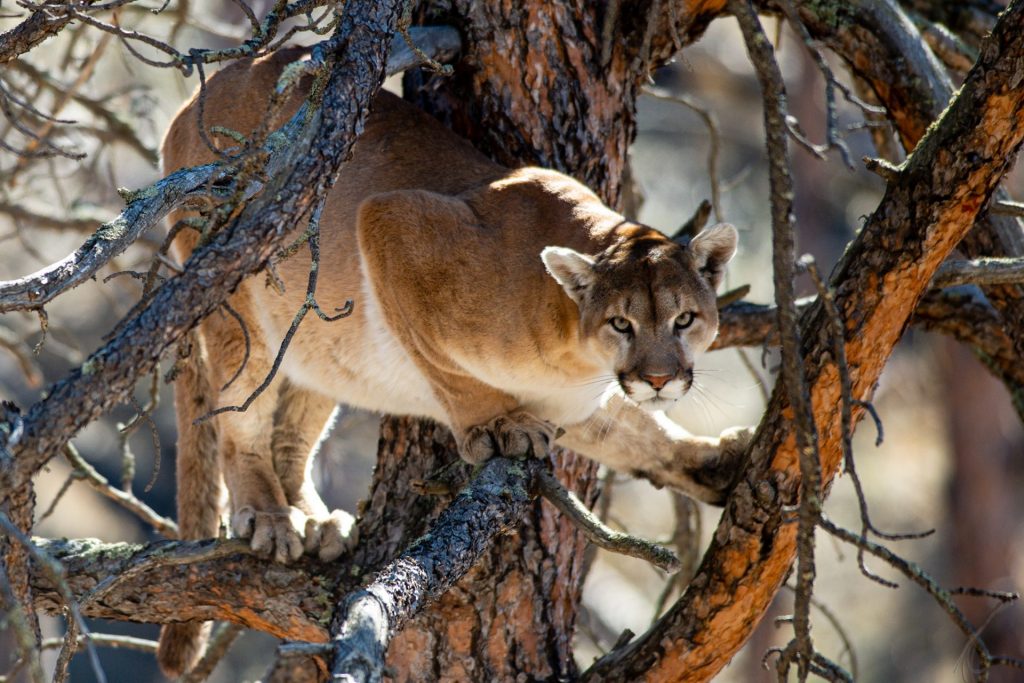
Story and photos by Justin Haag
Referred to as mountain lion, cougar and several other names, Puma concolor has become one of the most discussed wildlife species in the state. For all of that talking, though, it seems there is always a need to dispel a few myths and provide accurate information to the public regarding the species.
Historical accounts of the species in Nebraska, while sparse, date back to the Stephen H. Long expedition of 1819. Along with so many other species, cougars disappeared from Nebraska with Euro-American settlement. Not only did early settlers slay predators at every opportunity, more importantly they killed the predators’ prey. The decimation of deer and other prey species in the late 1800s and early 1900s surely made Nebraska a less desirable place for mountain lions to live.
The return of the mountain lion, not coincidentally, arrived at about the same time Nebraska was realizing the return of a flourishing deer population. As the Nebraska Game and Parks Commission began offering plentiful antlerless-only permits tags and bonus tags in the 1990s to manage the burgeoning deer population that was once nearly extirpated, cougars also found harvest opportunities of their favorite prey in Nebraska and began showing up to the party. The first modern confirmation of a mountain lion in Nebraska came in 1991, marking the cats’ expansion from large populations in bordering states where cougar and prey populations had recovered because of protection by game laws.
In discussions of mountain lion numbers, biologists are quick to point out that cougars do not adhere to any arbitrary borders and Nebraska’s cats are part of a larger population that extends to the Black Hills of South Dakota, the Rocky Mountains of Colorado and Wyoming, and other points west.
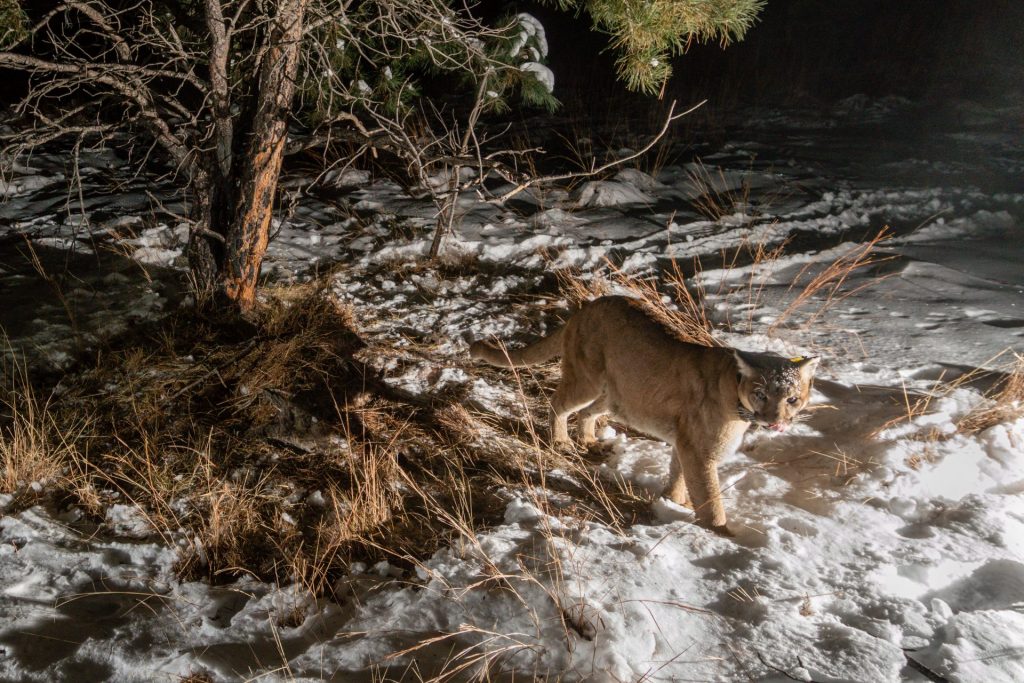
In 1995, the Nebraska Legislature classified mountain lions as game animals. A provision in state statute allows individuals to kill mountain lions if they are threatening their lives or property.
Game and Parks has established management programs that meet those statutory obligations and are designed to curtail negative interactions between humans and the cats, and has gone to great lengths to gain public input about the species, usually not having to work too hard to get it. It seems everyone has an opinion on this species, ranging from “get rid of them” to “just let them be.”
To help guide management decisions about the species, Game and Parks has opted to take a scientific approach rather than an emotional one. Biologists recognize the mountain lion as an important part of Nebraska’s biodiversity, but also strive to employ management strategies to maintain resilient, healthy and socially acceptable populations in balance with available habitat and other wildlife species over the long term.
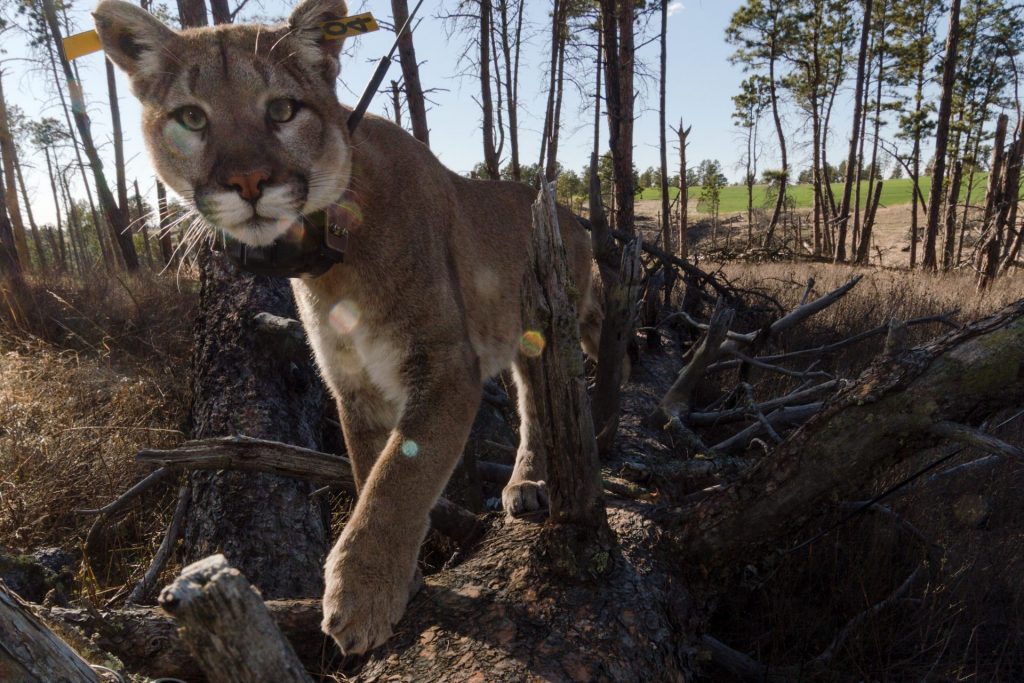
In 2015, Game and Parks ramped up its research efforts under the direction of Sam Wilson, furbearer and carnivore program manager. By capturing mountain lions and equipping them with GPS tracking collars, researchers have gained new insight into how this species is spending its time in the Pine Ridge. The research has not only given Nebraska officials a better idea of how many cats are in the area, but also what they’re eating and how they are using the terrain.
By using both the revered and well-established mark-recapture survey method coupled with modern genetic surveys, Game and Parks has gained confidence in its population estimates in the Pine Ridge. Remarkably, those two methods came up with exactly the same number of cats when the most recent population estimates were tabulated in 2017. Both survey methods arrived at 59 individuals in the Pine Ridge of Sioux, Dawes and Sheridan counties.
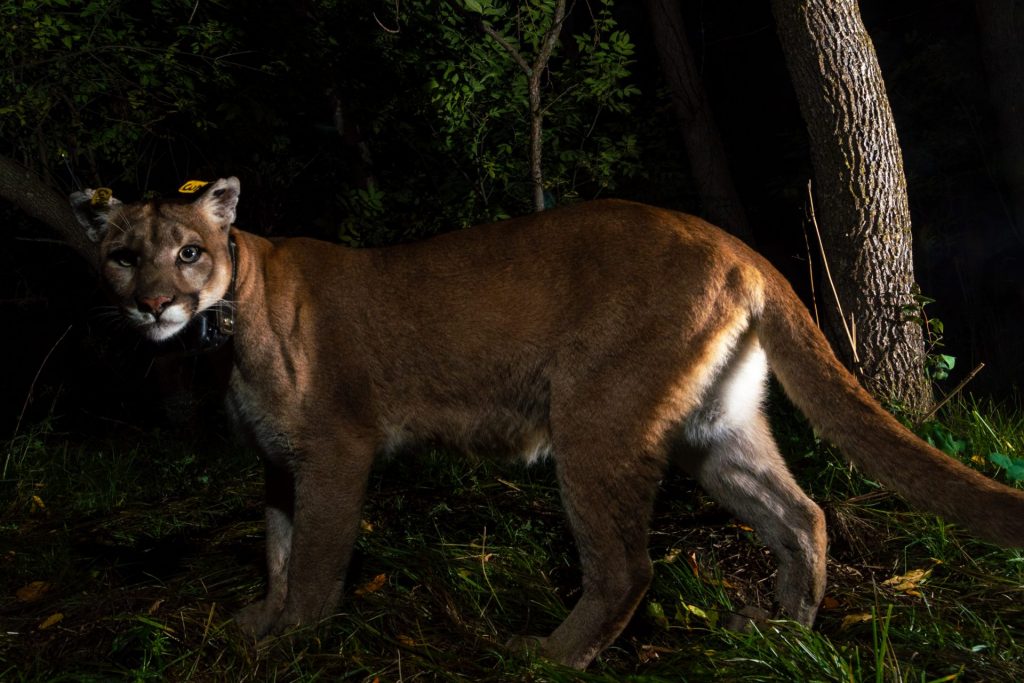
The population estimates and number of collared cougars in the Pine Ridge provide a safeguard against overharvest when hunting recommendations are made. Biologists do note, however, that the population is always fluctuating. Mountain lions reproduce, die and move in and out of the state.
Based on Game and Parks research, individual cats with tracking collars have traveled as far as 20 miles in one day. They have established breeding ranges in the Pine Ridge, Niobrara Valley and Wildcat Hills, but with individual females documented in southeastern Nebraska, Iowa, Missouri and Tennessee, it is possible that cats will expand their home ranges into other territories. Nebraska contains highly suitable habitat along creeks and rivers from border to border.
Getting the Picture on Pumas
The following material has been obtained with invaluable assistance from Game and Parks’ wildlife division employees, some who have moved on to other positions since the photos were taken. Certain imagery was captured with camera in hand, while some of the photos were snapped by a high-resolution camera trap system with external trigger and strobes.
Regardless of which side of the mountain lion issue one stands, it seems there are no shortage of misunderstandings about this elusive species. Thanks to the research in Nebraska and elsewhere, we are continuing to answer questions that will help all gain a better understanding.
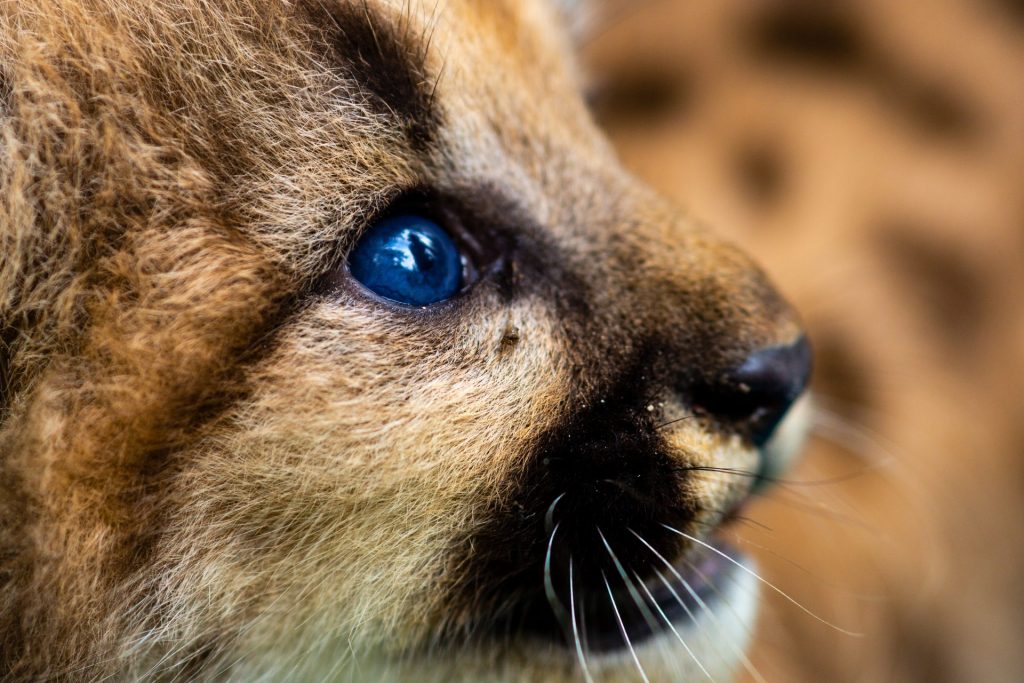
It’s hard to believe an animal that looks like this may grow into something capable of bringing down a bull elk, isn’t it? Mountain lion kittens, also correctly referred to as cubs, are born at just over one pound with a spotted coat and blue eyes. They get bigger. Adult female mountain lions typically weigh in at 85-110 pounds, while toms are 120-180. They measure 7-8 feet from nose to tail and 2-3 feet in height at the shoulder.
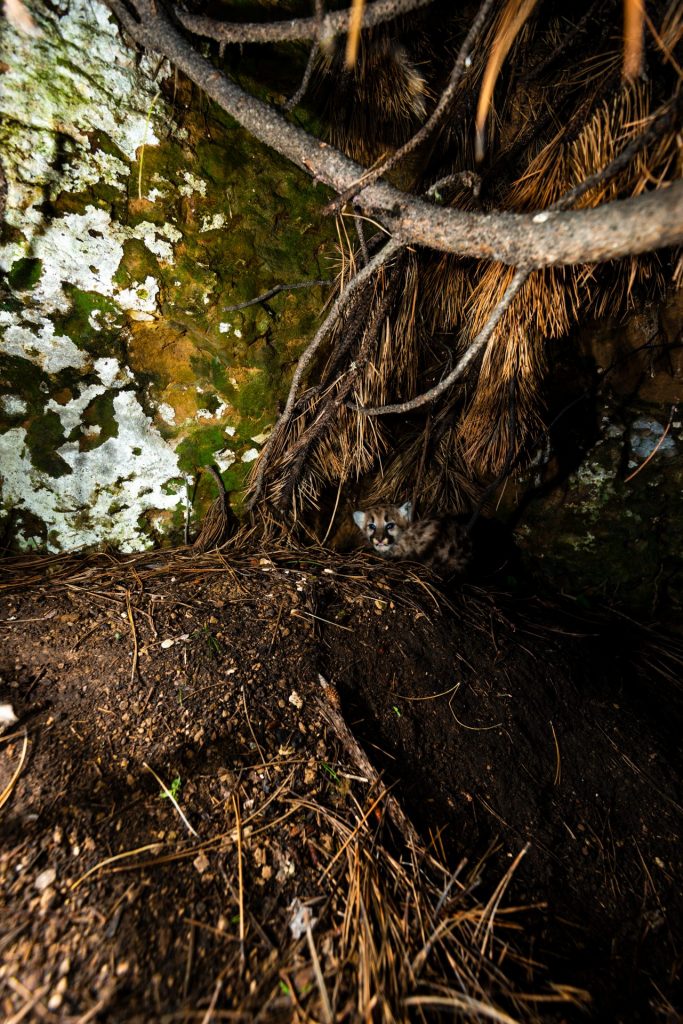
Researchers tag the kittens when they are four to five weeks old – any earlier and they put the kittens at risk, any older and they are hard to catch. The kittens are surprisingly docile during the process. Dens are sometimes found tucked under picturesque rock overhangs such as this one, but more frequently under the entangled branches of downed trees. The spotted fur, which fades out over their first year, makes for effective camouflage.

People often mistake tracks of large dogs for those of mountain lions. Note that this cougar track in the Sioux County snow has no evidence of claw marks. Unlike canid species, the big cats walk with their claws retracted so they are rarely visible in prints.
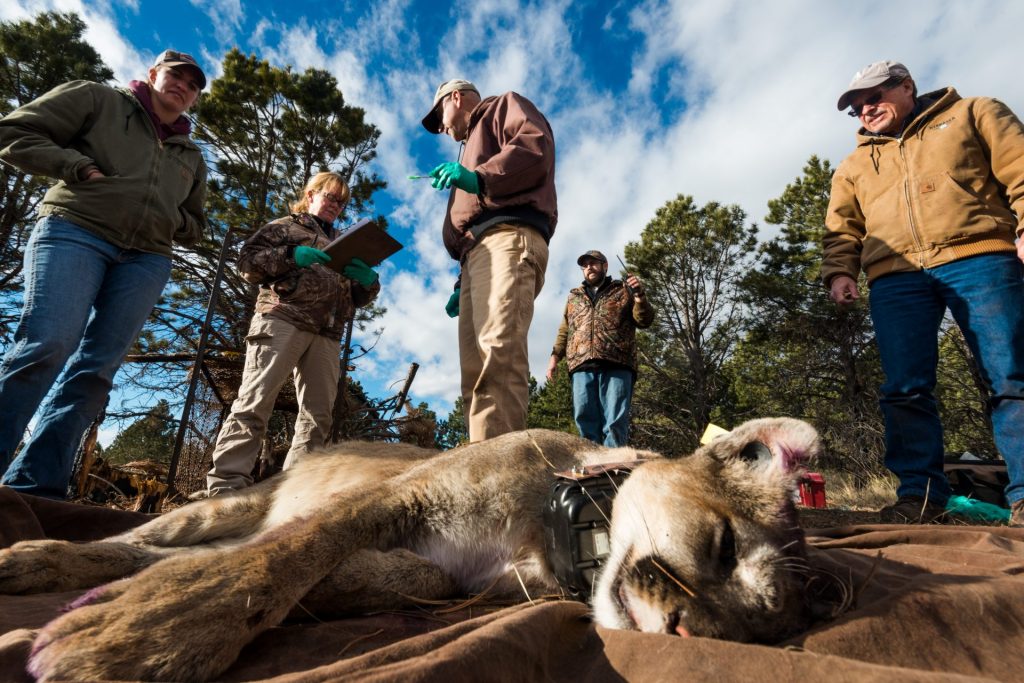
In 2015, Game and Parks staff members Mallory Irvine, Laura McHale, Todd Nordeen, Micah Ellstrom and Greg Schenbeck stand near the first cougar to be trapped, immobilized and collared for research in the Pine Ridge. Researchers employ traps or dogs to capture mountain lions for collaring. The traps are designed to do no harm to the animals. When treeing a cat with dogs, researchers dart the animal and take care in getting it down. Sometimes, a staff member must climb a tree and lower the immobilized cat off a limb into a safety net.
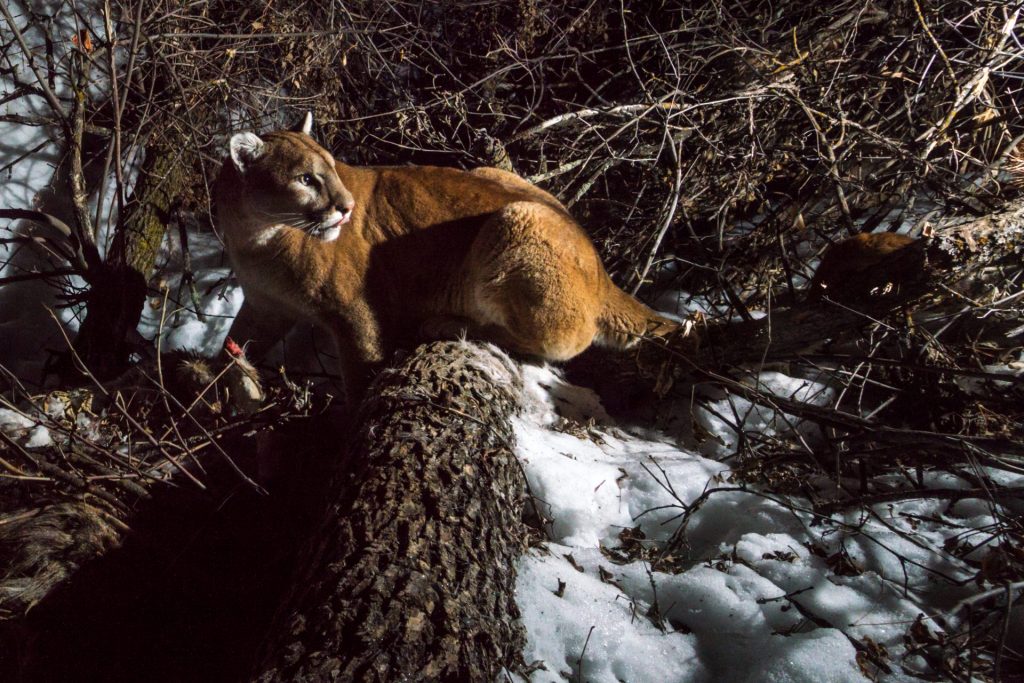
Mountain lions are extraordinarily stealthy and rarely seen in the wild, known to typically flee or stay hidden when they sense humans. Fatal attacks do happen on rare occasion, though, and as this species re-establishes its range and humans increase development within the same areas the occasional encounter is sure to ensue. People living in or visiting cat country are wise to learn about the species, how to respond appropriately to their presence and best methods for protecting domestic animals. Dispersing young males, which are learning to hunt and establish a territory, are the most usual suspects when encounters occur with livestock and people.
This uncollared cat, photographed in Sheridan County, apparently watched me as I followed a dragline in the snow to find a deer it had cached at a creek bottom. Little did I know, until hearing some scurrying, that it had had been watching me approach its food. I watched the cat as it hurried from its resting place to the top of the canyon and saunter away on the ridgeline above. The indention in the snow where the cat had been resting was just 15 steps away from me. The cat did what almost all of them do in similar situations – chose to abandon its groceries and flee human presence. I got this photo later that night after anxiously setting the camera trap near its food cache atop the frozen creek.

Take note of the ear tags in these two photos (above and below). While the tags are the same, the cat has certainly changed from one photo to the other. Researchers occasionally have multiple experiences with individual mountain lions. I photographed this one with Sam Wilson in August 2015 while it was being tagged as a four-week-old kitten, and 17 months later when it was captured and collared a few miles away as a young adult.
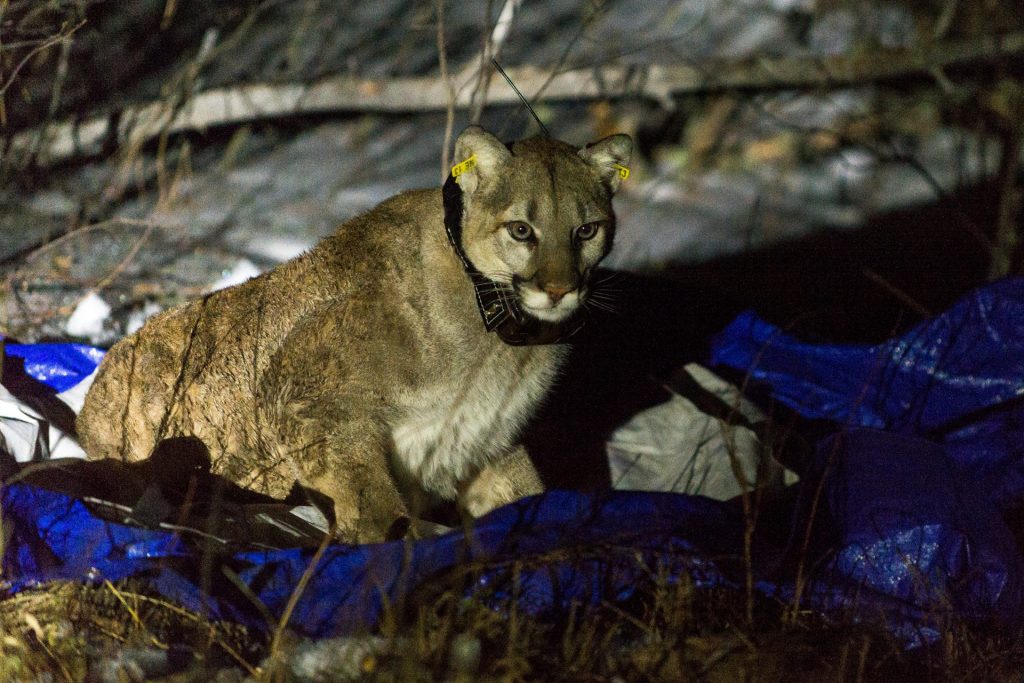
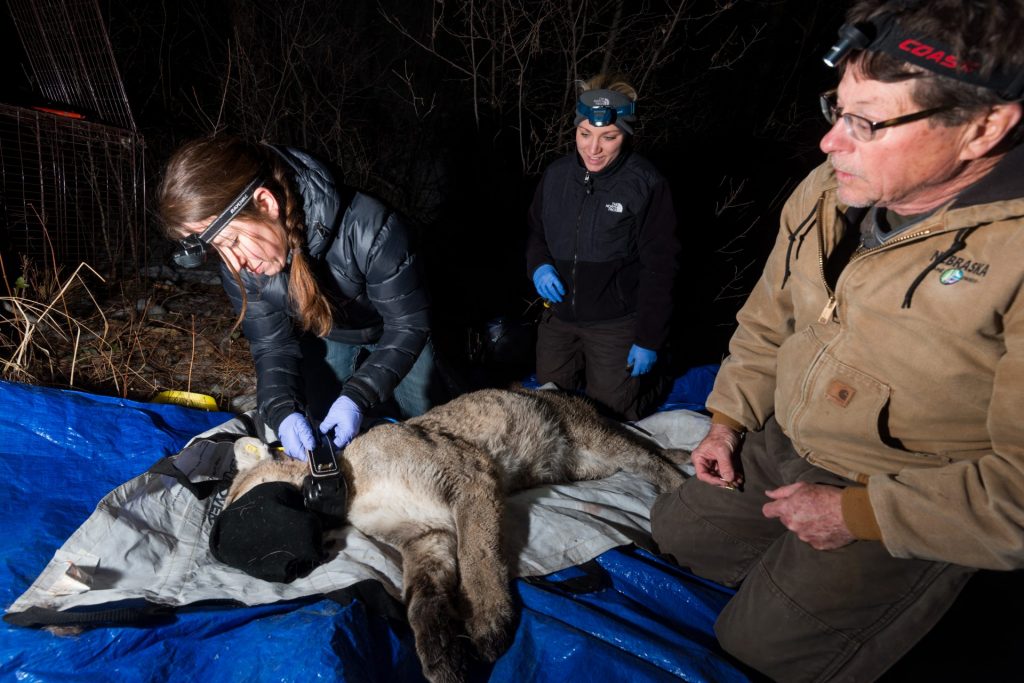
Cougars rarely cooperate with normal working hours. Here are Game and Parks employees Linsey Blake, Maria Baglieri and Greg Schenbeck collaring a tranquilized mountain lion at 12:46 a.m. in the January 2017 darkness. As of this writing, 14 cougars were carrying working collars in the Pine Ridge. Researchers have installed collars many more times than that, though. The total number, which has been as high as 17, fluctuates as transmitters become inoperable, cats die and researchers laboriously capture and recollar cats.
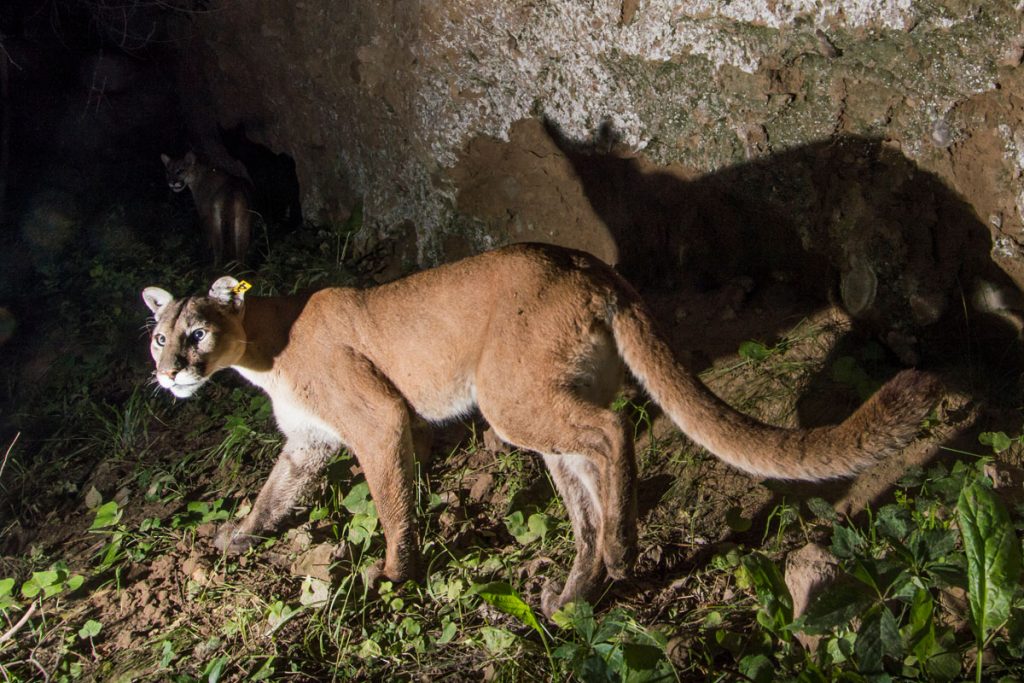
Cougars are usually solitary animals – loners. Look closely, though, and you will see two mountain lions in this photo – the tagged mother cougar in the foreground, which had lost its tracking collar, and one of its two kittens in the background. Trail camera photos of female cougars with kittens nearing dispersal age have garnered a lot of attention on social media in recent years, especially if the kittens are old enough that people wrongly assume they are adult cats “hunting in packs.”
Female cougars reproduce at 2-3 years old and may do so at any time of the year – most often in warmer months. The litters average 2-4 kittens, as younger females usually give birth to smaller litters. Kittens stay with their mothers for about a year and a half, so, at a glance, can appear to be adults toward the end of that period. Figure in a 90-day gestation period, and it works out to a litter of kittens about every two years for each female if nature allows. Frequently, though, the kittens do not survive, and the female will become sexually receptive ahead of that schedule. In fact, toms are known to kill kittens, especially those they did not father, in order to trigger the female back into breeding.
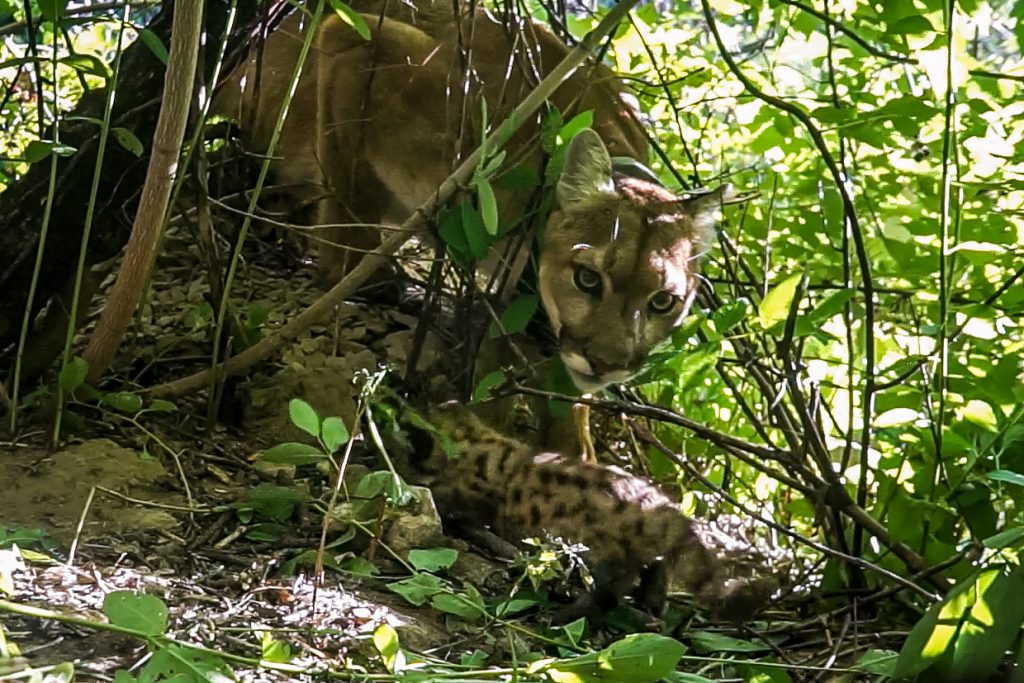
Linsey Blake and I placed a video camera trap near this kitten while its collared mother was away from the den. If mom is away, mountain lion kittens often chirp as the video showed. Not a lot of research exists for mountain lion hearing, but videos such as this beg questioning whether the mother cougars’ ears are specially tuned to hear the frequencies being emitted by the kittens’ chirps. To the unknowing human, the chirps seem to be from a bird. See the video at https://www.youtube.com/watch?v=raz8Wat2RyA.
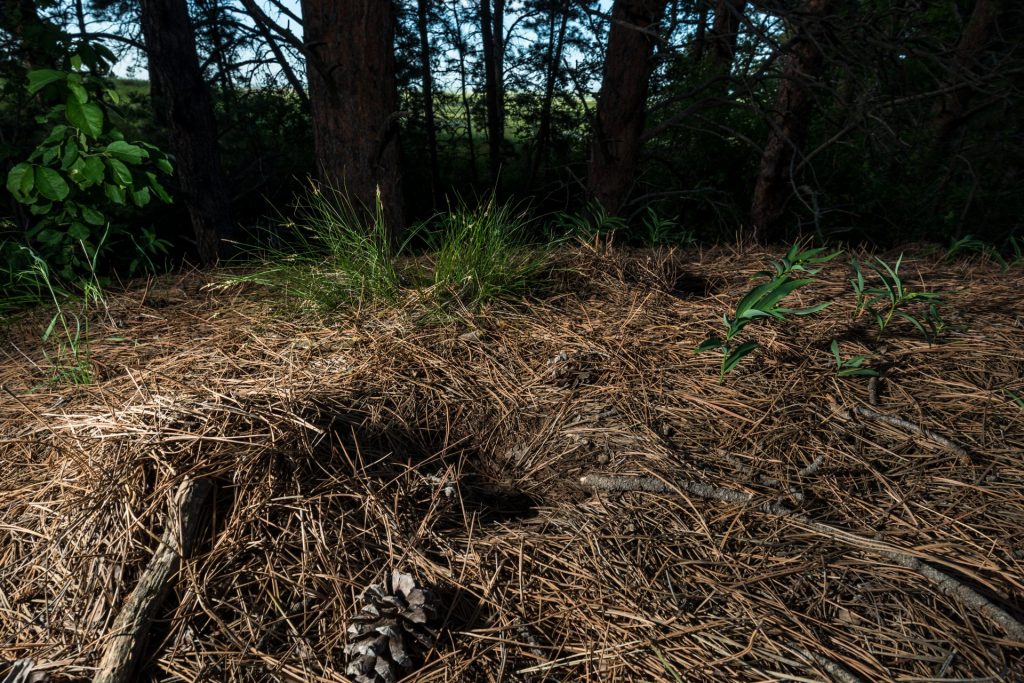
Male cougars create a small mound using available dirt and other materials, known as a scrape. This provides an elevated post for the cat to mark its spot with urine. Scrapes provide a way for toms to communicate with females, their potential mates, and to warn other competing or intruding toms of their presence. Because male lions are so territorial, direct interactions often result in violence and perhaps death to the weaker male. Scrapes allow communication and declaration of territory boundaries without the risk of direct interactions.
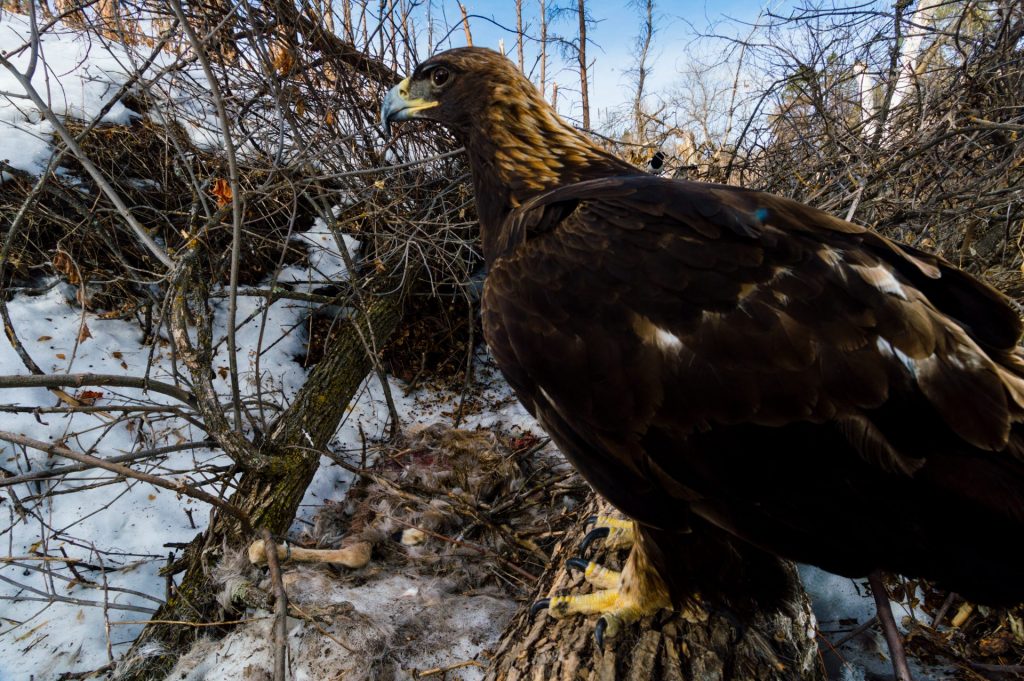
Predators’ effects on biodiversity are often misunderstood, as they are perceived as bloodthirsty killers that only take from the scene. While the cats no doubt kill many deer and other animals, potential benefits from their existence must also be realized. For instance, as a matter of efficiency cougars often first prey upon easily targeted ill or weak animals. Consequently, the herd may benefit from improved genetics and reduced disease transmission. In addition, recent research in the West has shown that mountain lion kills can be beneficial to many other species. At this site in Sheridan County, black-billed magpies (below) and golden eagles (above) feasted on a cached white-tailed deer – still leaving some for the cat to eat, of course.
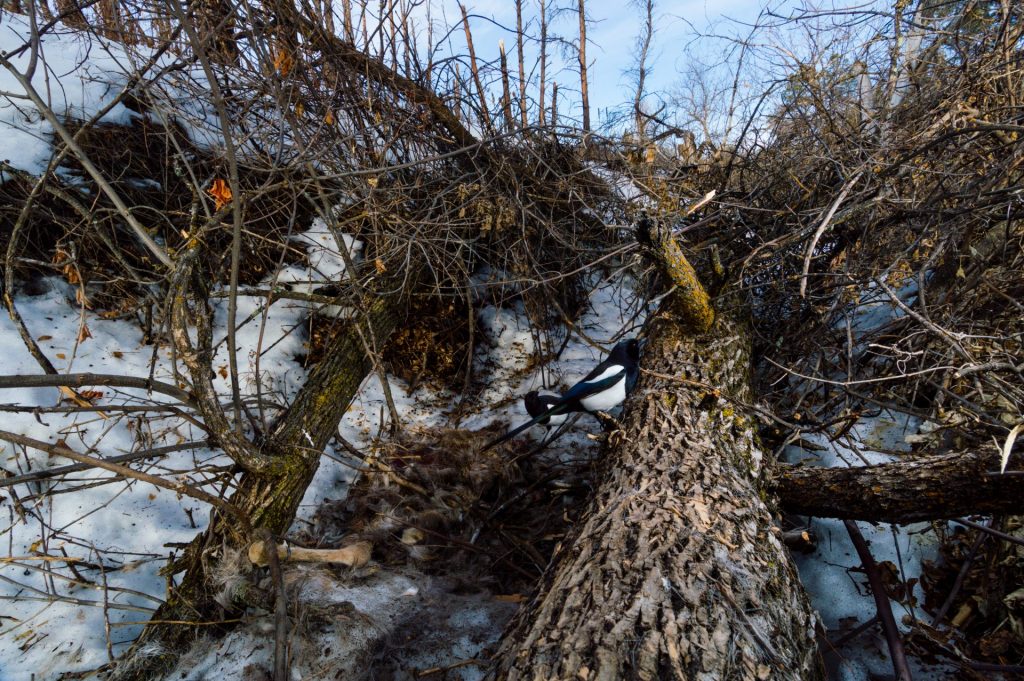
Five genetic surveys of the Pine Ridge, dating back to before the collaring project began, have been extremely valuable for making population estimates. Karen DeMatteo (below with Linsey Blake) has taught her dog, Train, to be proficient at finding mountain lion scat. Whether he’s in Nebraska or Argentina, he’s good at it.
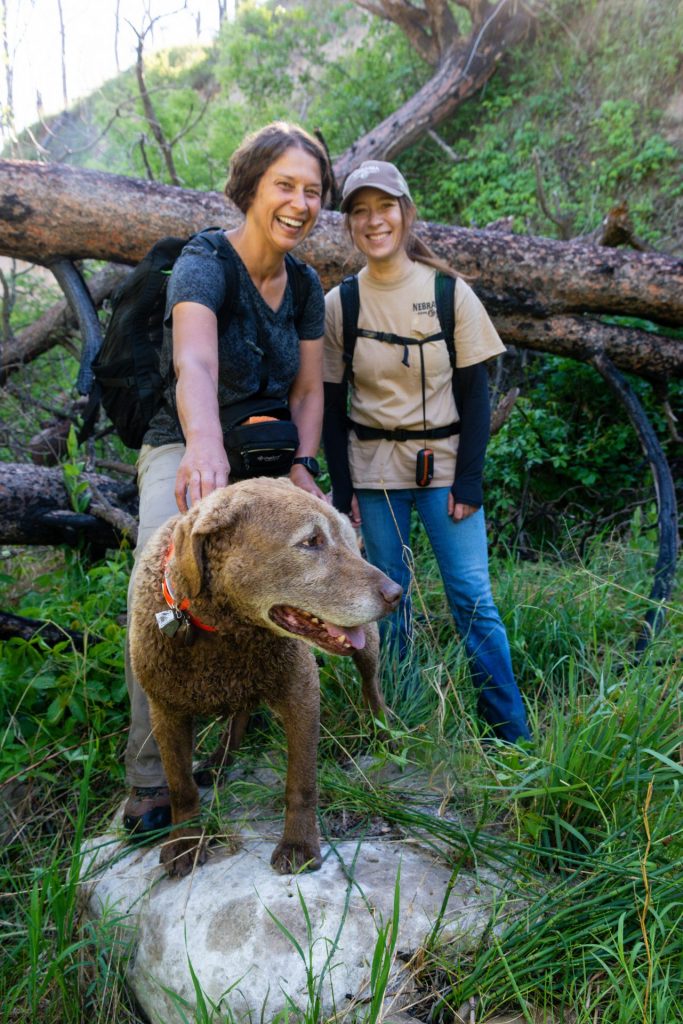
Upon collecting the scat (below), samples are swabbed and sent to a lab for genetic analysis.
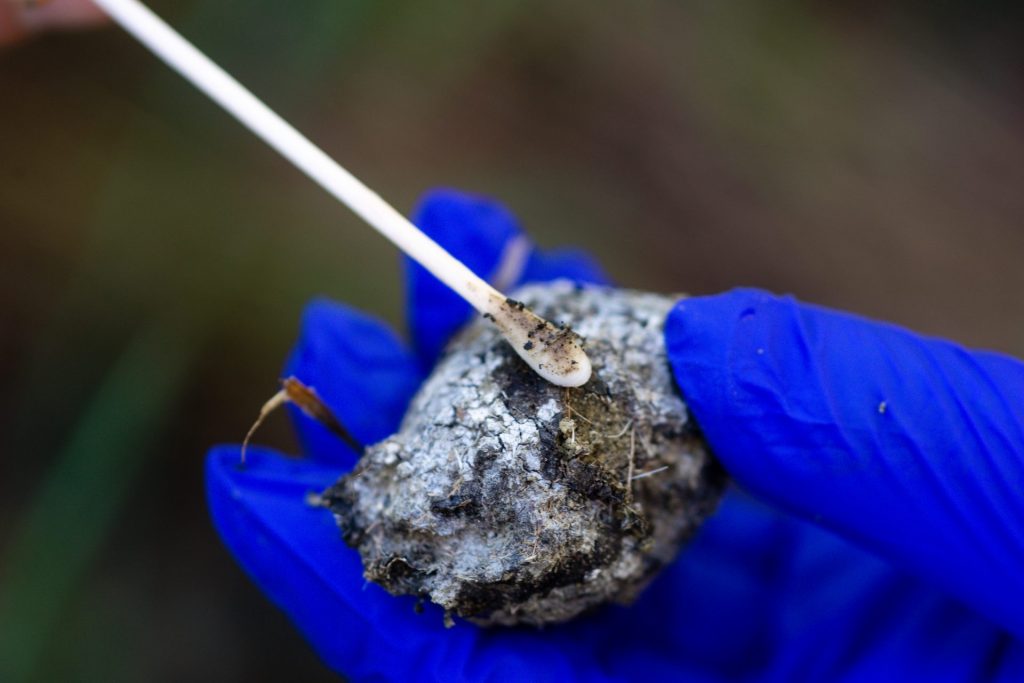
DeMatteo, Train and Game and Parks staff hiked 321.75 miles this year over rugged Pine Ridge terrain. From those extensive searches researchers have the opportunity to obtain DNA from all cougars in the region at a given time, aside from kittens in dens.

The researchers get plenty of exercise examining clusters, which by nature are often in extremely rugged terrain. Game and Parks employee Lauren Toivonen (below), who joined the project this year, shows off the carefully created tracks on her GPS unit after investigating a site in Dawes County. Until researchers find evidence, they closely examine each nook and cranny of an area 100 meters in diameter with a path spiraling from the center of the cluster. While Toivonen’s path in the photo may look simple on the GPS unit, it included a steep sandstone ridge on its east side and a barbed-wire fence that was crossed eight times – not to mention a large patch of poison ivy. Studying mountain lions and their clusters takes the researchers to some of the most remote, beautiful, but difficult-to-access places in the Pine Ridge in many kinds of weather.
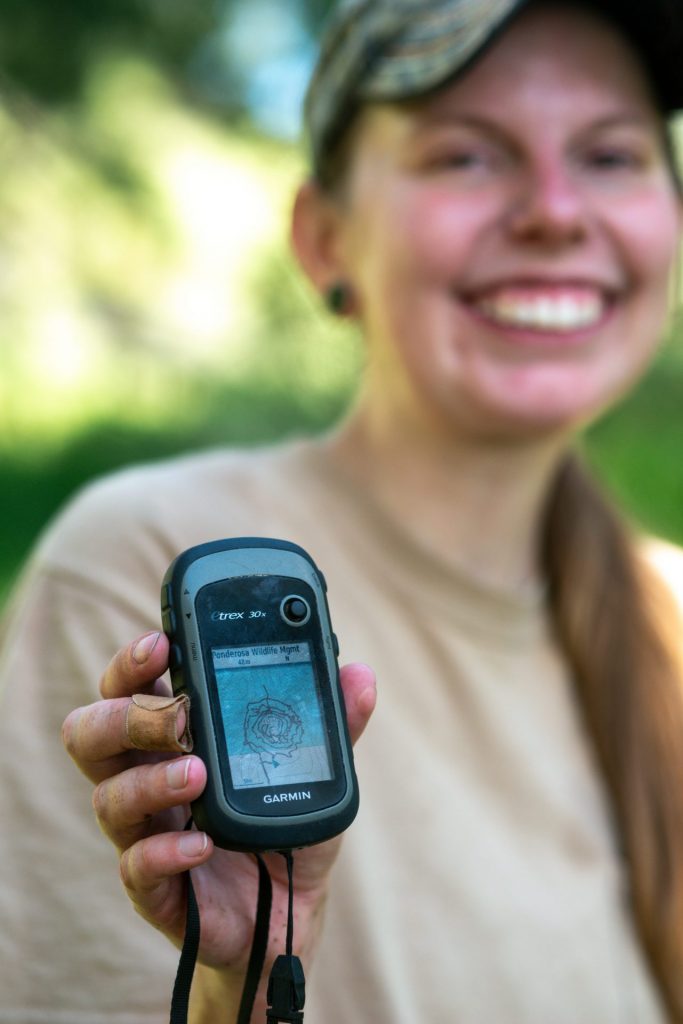
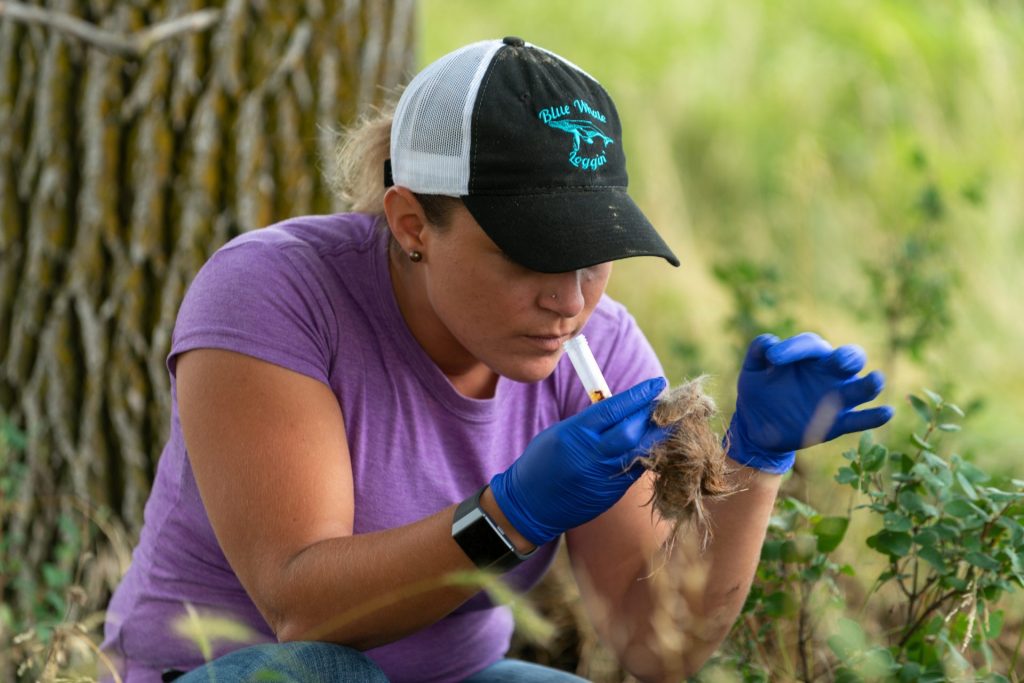
While more than 75 percent of the prey evidence found at the Nebraska cluster sites have been of deer, the hair of which Maria Baglieri is studying (above), occasionally the monotony is broken by the discovery of another species such as bighorn sheep (below), as Linsey Blake and Baglieri are examining. Despite traversing territory with plentiful livestock, less than 1 percent of the prey evidence discovered by Nebraska’s researchers have shown evidence of cougars preying on cattle or other domesticated animals.
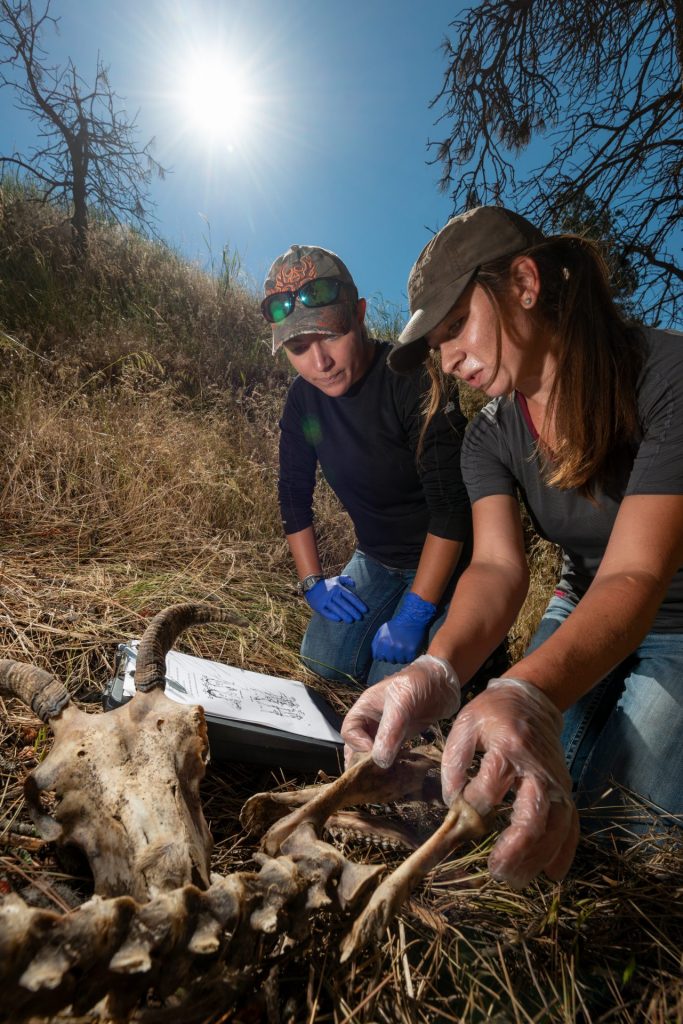
Learning into the Future
Nebraska’s mountain lion research is scheduled to continue. Critical to that research is the cooperation received from farmers, ranchers and other landowners in the study area. Whether it is allowing captures, cluster examinations or trail cameras on their property, landowner support and input is always welcome to the efforts and aids the research.
“Our mountain lion management and research could not be successful without their help and cooperation,” Wilson said.
Even though Game and Parks has gathered a wealth of information about this remarkable species, there is certainly more to learn. By combining a variety of methods, both researchers and the greater public can learn about a species that gets a lot of attention by many but is rarely seen. ■
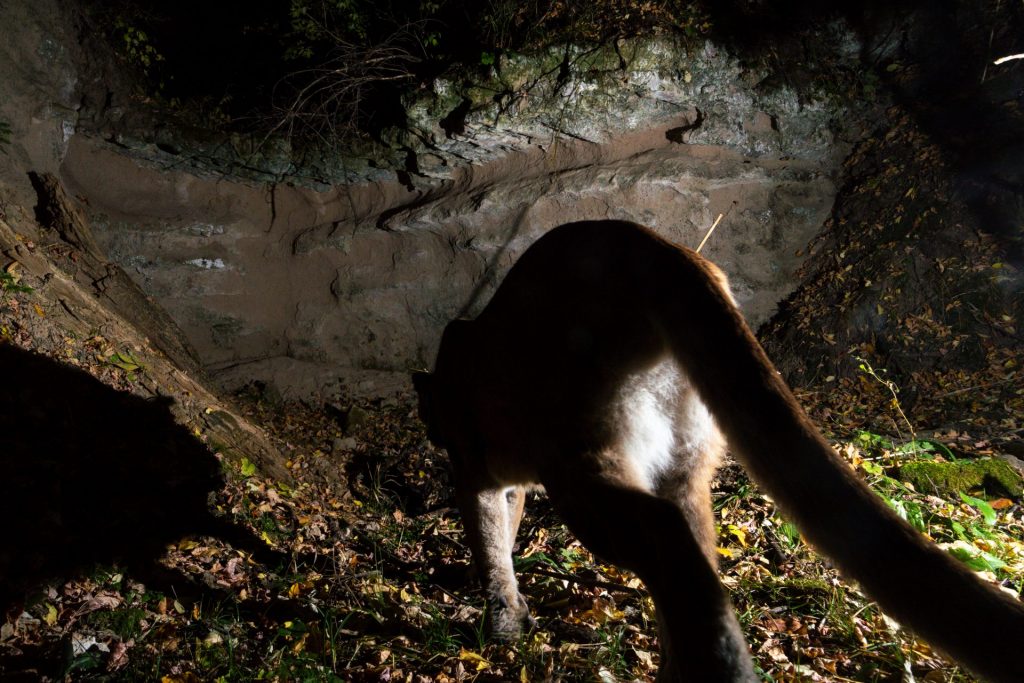
A mountain lion investigates a rock cranny in the Pine Ridge. At a quick glance, the tail is a feature that effectively differentiates the appearance of a mountain lion (especially a young one) from a bobcat, the smaller wildcat species in Nebraska. At 2-3 feet long, the cougar’s long, muscular dark-tipped tail makes up about 40 percent of its body length and provides counter balance while climbing and during quick turns over uneven terrain. The bobcat’s tail, in contrast, makes up less than 10 percent of its body length at five or six inches.
In Case of an Encounter
Because of cougars’ secretive nature and low density, they rarely interact with humans. In the rare event of an encounter, follow these guidelines.
- Do not approach a mountain lion.
- Leave the animal an avenue of escape.
- Stay calm, move slowly.
- Back away safely if you can. Do not turn your back to the lion or start running.
- Raise your arms or backpack to appear larger.
- Lift up your children to prevent them from running.
- If you are being attacked fight back. Mountain lion have been successfully driven off with bare hands.
- Use rocks, or whatever you can get your hands on. Try to remain on your feet or get back up if knocked down.
Why a Hunting Season?
By Sam Wilson, Wildlife Biologist

The Nebraska Game and Parks’ management goal for mountain lions is to maintain resilient, healthy, and socially acceptable mountain lion populations that are in balance with available habitat and other wildlife species over the long term. Mountain lions are a native species and part of the heritage of our state, so we want to ensure they are around for generations to come; however, our challenge is to manage both the biological and the social aspects of having mountain lions in Nebraska.
We manage populations of game animals such as mountain lions through harvest seasons. Deer, elk and turkeys are just a few examples of game animals thriving with careful management that includes hunting.
Game populations are evaluated annually to determine what, if any, harvest should be allowed. The basic premise is that when populations increase, harvest levels can increase, and when populations decrease, harvest can be reduced or stopped. Management through hunting may benefit the health of the species by reducing the probability of disease events, territorial conflicts, and starvation which may occur more often when population levels are very high. Hunting also ensures the population is maintained at an acceptable level for the people living in the area.
Mountain lion population estimates in the Pine Ridge have increased dramatically over the last few years, from 22 total animals (kittens and adults) in 2014 to 59 during the 2017 survey. By 2017, estimates of mountain lion density (the number of animals in a given area) was much higher in the Pine Ridge than densities in most western states with a harvest season.
At the same time the population estimates increased, we began experiencing problems with livestock depredation. Public input from people living in the Pine Ridge area indicated that the population level was above what many landowners were willing to accept. A carefully regulated harvest season, with a limit on the number of mountain lions harvested, allows Game and Parks to meet the management goal of maintaining a resilient, healthy, and socially acceptable population in the Pine Ridge.
This is the same proven strategy that has allowed other game species to thrive in Nebraska and ensures mountain lions will remain in our state for generations to come.
 Nebraskaland Magazine
Nebraskaland Magazine


